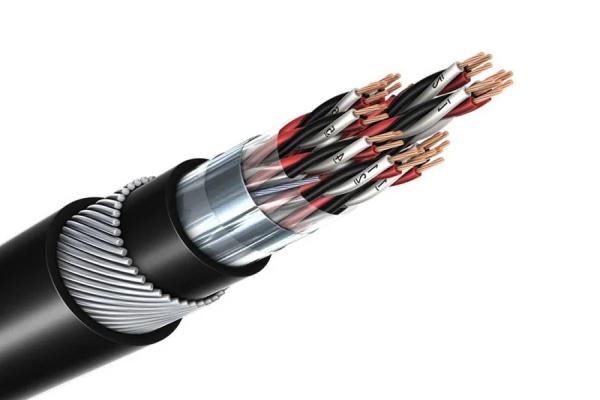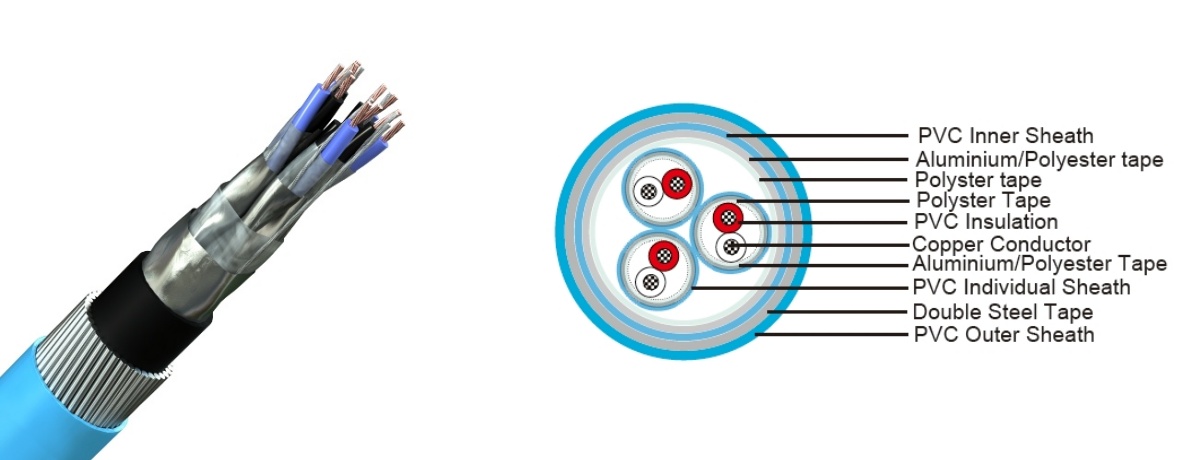

Багаж хэрэгслийн кабелийн кабель нь аж үйлдвэрийн болон арилжааны тохиргоонд чухал бүрэлдэхүүн хэсэг юм, Тоног төхөөрөмжийг хянах, хянах, хянах дохиог дамжуулахад ашигладаг. Тэд цахилгааны дуу чимээг танилцуулж болох орчинд бүрэн бүтэн байдлыг хадгалах зорилготой юм, механикийн стресс, байгаль орчны аюул. Эдгээр кабель нь нарийн хяналт, хэмжилтийн явцад чухал ач холбогдолтой юм, тухайлбал химийн ургамал гэх мэт, цахилгааны үе үе үе үе, Газрын тос, хийн үйлдвэрүүд, болон автоматжуулалтын системүүд. Энэ эссэ Veri кабель судалж байна багаж хэрэгслийн төрөл бүрийн кабелийн, тэдгээрийн тодорхой загварууд, ба тэдний програмууд, орчин үеийн технологийн ландшафтод ач холбогдлыг онцлон тэмдэглэв.


Хэрэгслийн кабелийн кабель янз бүрийн тохиргоонд ирдэг, Тодорхой шаардлагыг хангахад зориулагдсан. Үндсэн төрлүүд орно:
Хосолсон кабега нь тусгаарлагдсан хоёр дамжуулагчийг хооронд нь туулав. Энэ тохиргоо нь цахилгаан соронзон хөндлөнгийн оролцоог багасгахад тусалдаг (EMI) зэргэлдээ хосуудын хоорондох. Хосуудын мушгирах нь дохиоллын бүрэн бүтэн байдлыг хадгалахад зайлшгүй шаардлагатай байдаг.
Хэрэглээ:
TRIAD Cables нь тусгаарлагч гурван дамжуулагчийг хооронд нь туулав. TIAD тохиргоо нь нэг кабель дотор олон тооны дохионы замыг шаарддаг програмд ашиг тустай байдаг, Олон кабелийн гүйлтийн хэрэгцээг бууруулах.
Хэрэглээ:
Олон хос кабель нь хэд хэдэн хосыг эрчилсэн дамжуулагчаас бүрддэг, Олон тооны дохиог нэг кабелиар дамжуулж өгөх боломжийг олгодог. Эдгээр кабель нь утсыг хялбаршуулах, хялбаршуулахад шаардагдах физик орон зайг багасгахад их давуу талтай байдаг.
Хэрэглээ:
Багаж хэрэгслийн кабелийг хамгаалах эсвэл хамгаалалтгүй байж болно. Шилдэг CASS нь EMI-ийн эсрэг хамгаалах зорилгоор дамжуулагчийн эргэн тойронд дамжуулагч материалыг агуулдаг. Хамгаалалтгүй кабель, Нэрийг санал болгож байна, Энэ давхарга байхгүй байна.
Бамбай кабель програмууд:
Хамгаалалтгүй кабель програмууд:
Термопарын өргөтгөлийн кабелийг тусгайлан боловсруулсан болно термопаруудыг хэмжих хэрэгслийг хэмжих. Эдгээр Cables нь температурыг нарийвчлалтайгаар хангахын тулд термопартай нийцтэй материалаас тохирох ёстой.
Хэрэглээ:
Fieldbus кабелийг дижитал хэлбэрээр ашигладаг, Аж үйлдвэрийн автоматжуулалтын хоёр талын харилцаа холбооны систем. Эдгээр кабель нь олон тооны төхөөрөмжийг нэг сүлжээнд холбогдсон байх боломжийг олгодог.
Хэрэглээ:
Багаж хэрэгслийн янз бүрийн загварууд нь тодорхой стандарт, програмыг хангах зорилготой юм. Эдгээр загварууд нь багтдаг:
Pltc кабелийг кабелийн тавиур болон бусад үйлдвэрлэлийн орчинд суурилуулах зориулалттай. Тэд цахилгаан хязгаарлагдмал хэлхээнд тохиромжтой бөгөөд үндэсний цахилгаан кодыг дагаж мөрдөхөд тохиромжтой (NEC) шаардлага.
Хэрэглээ:
Тавиурын кабель (Тбо) Тавиур дээр суурилуулах зориулалттай олон талт кабель нь, нэхэмжлэл юм, болон бусад уралдааны замууд. Тэдгээр нь олон төрлийн аж үйлдвэрийн өргөдөлд тохиромжтой бөгөөд трейк кабелийн шаардлагыг биелүүлэхэд тохиромжтой.
Хэрэглээ:
Pltc-er кабель нь Pltc кабельтай төстэй боловч ил гарсан гүйлтэд үнэлгээтэй байдаг, хязгаарлагдмал зайд суваг, кабелийн тавиурын гадна суулгаж болно гэсэн үг. Энэ нь суулгалтыг илүү уян хатан, зардал багатай болгодог.
Хэрэглээ:
ITC ITC кабель нь багаж хэрэгсэл, хяналтын програмд тусгайлан боловсруулсан болно. Тэд EMI-ийн эсрэг давуу эрх олгодог бөгөөд тавиур дээр суурилуулахад тохиромжтой, нэхэмжлэл юм, болон уралдааны замууд.
Хэрэглээ:
Багаж хэрэгслийн кабель нь янз бүрийн үйлдвэрүүдэд зайлшгүй шаардлагатай байдаг, үнэн зөв өгөгдөл дамжуулах, хянах. Зарим гол програмууд орно:
Газрын тос, байгалийн хийн салбарт, Багаж хэрэгслийн кабель нь янз бүрийн үйл явцыг хянах, хянахад чухал юм. Ашиглаж байна:
Цахилгаан эрчим хүчний байгууламжууд нь багаж болон хянах, хянах зориулалттай багаж хэрэгслийн кабель дээр нэлээд их найддаг. Програмууд орно:
Химийн болон эмийн үйлдвэрүүдэд, нарийвчлал, найдвартай байдал нь параунт юм. Багаж хэрэгслийн кабелийг ашигладаг:
Төрөл бүрийн салбарт дамжуулан автоматжуулалт, хяналтын систем нь найдвартай мэдээллийн дамжуулалтад хамаарах кабелийн кабелийн кабелийн кабешноос хамаарна.
Програмууд орно:
Харилцаа холбоо, Багаж хэрэгслийн кабель нь найдвартай мэдээллийн дамжуулалтад зайлшгүй шаардлагатай. Програмууд орно:
Багаж хэрэгслийн кабелийн кабелийг орчин үеийн аж үйлдвэрийн болон арилжааны програмд чухал үүрэг гүйцэтгэдэг, үнэн зөв, найдвартай өгөгдлийг дамжуулах, хянах. Багаж хэрэгслийн кабелийн янз бүрийн хэлбэр, загварууд нь тодорхой шаардлагыг хангах зорилготой юм, Өндөр цахилгаан соронзон хөндлөнгийн оролцоотой орчныг хангах, механикийн стресс, байгаль орчны аюул. Газрын тос, хийн үйлдвэрээс цахилгаан үүсгэдэг, химийн үйлдвэрлэл, Автоматжуулалтын системүүд, болон харилцаа холбоо, Багаж хэрэгслийн кабель нь шүүмжлэлийн үйл явцын бүрэн бүтэн байдал, үр ашгийг хадгалахад зайлшгүй шаардлагатай. Янз бүрийн хэрэгслийн кабелийн кабелийн янз бүрийн хэлбэрийг ойлгоход тэдгээрийн програмууд нь тодорхой хэрэгцээ тус бүрийн зөв кабелийг сонгоход тусалдаг, оновчтой гүйцэтгэл, найдвартай байдлыг хангах.
Хүмүүс эрдэс бодисыг тусгаарлагдсан кабелийг сонсох үед, many immediately think of harsh environments like…
Харилцаа холбоо, цахилгаан дамжуулах системүүд хурдан ургадаг, the demand for reliable and cost-effective…
Том хэмжээний тос, хийн төслүүдэд, Аж үйлдвэрийн кабель нь зөвхөн дагалдах хэрэгсэл биш юм—they are the "nervous…
Цахилгаан холболтын ертөнцөд, кабелийн залгуур—кабелийн чих эсвэл кабелийн терминал гэж нэрлэдэг—байна…
Цахилгааны инженерийн төсөлд зөв резинэн кабель сонгохдоо, it is critical to…
Эрхэм хүндэт түншүүд, үйлчлүүлэгчид: 1-р сарын 29-ний өдөр, 2025 Хятадын Цагаан сарын баяр – Spring…